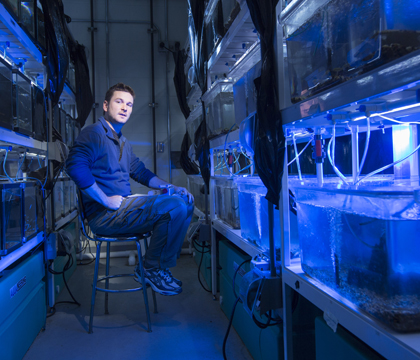
Fish behaviour flags environmental change
Newly hatched baby turtles on Florida's coast have been known to rush away from the ocean, rather than toward it as they normally would do.
By U of S CommunicationsThat's because the neighbouring street lights and other major light sources limit their ability to locate the moon, their natural guide to water, exposing them to unknown risks such as traffic and predatory birds.
This is an example of how human impact on the environment can pose a serious threat to wildlife, changing an animal's behaviour and its response to external threats, said University of Saskatchewan PhD biology student Adam Crane.
Through the federal agency NSERC, Crane has been awarded a $150,000 Vanier Canada Graduate Scholarship over three years to study these problems in fish and tadpoles.
"Rapid environmental change is a major threat to biodiversity, whether it is climate change, habitat destruction or invasive species," Crane said.
"We are trying to understand how these changes affect the basic cues animals are using in their daily activity."
Changes to the environment can decrease animal numbers, disrupt the balance of the food chain and lead to extinction in the long run, he said.
Crane will study fish behaviour both in Canada and off Australia's Great Barrier Reef, an environment at risk due to global climate change, poor fishing practices and pollution.
He aims to learn whether fish in such different locations show similarities in how they respond to predators as the environment around them changes. He will also study how factors such as increased water temperature and acidity can interfere with responses to predators.
"We can assess changes in the behaviour of animals as an early indicator of environmental problems," said Maud Ferrari, Crane's supervisor and an assistant professor at the Western College of Veterinary Medicine. "This can help us protect species from human-induced threats."
When a fish is captured by a predator, its skin releases an alarm chemical which warns other fish of the threat. But environmental change may severely affect a fish's sense of smell and its natural ability to detect the chemical and defend against predators.
Crane will do experiments to teach tadpole embryos to recognize potential predators. He will expose the tadpoles to the alarm chemicals which make their way inside the jelly eggshell to the embryo, and then check whether environmental changes have negative short- and long-term consequences on the tadpoles' ability to respond when a threatening situation occurs.
Crane's innovative behavioural research is less invasive and more cost-effective than other methods, and it has promising practical applications.
His techniques for training prey animals may be applied to hatchery and conservation programs of endangered species, improving their ability once they are released into the environment to face predators.
The university's strong reputation in this area of biology was what persuaded him to move his young family to Saskatchewan from Missouri, he said.
"For three decades, researchers at the U of S have led the field in studying predation risk and learning about predators of aquatic species," he said. "In my opinion, the U of S is the number one predation ecology program in the world."
Article written by Federica Giannelli, a graduate student intern in the U of S research profile and impact unit. This article first ran as part of the 2014 Young Innovators series, an initiative of the U of S Research Profile office in partnership with the Saskatoon StarPhoenix. Reposted with permission from news.usask.ca.
